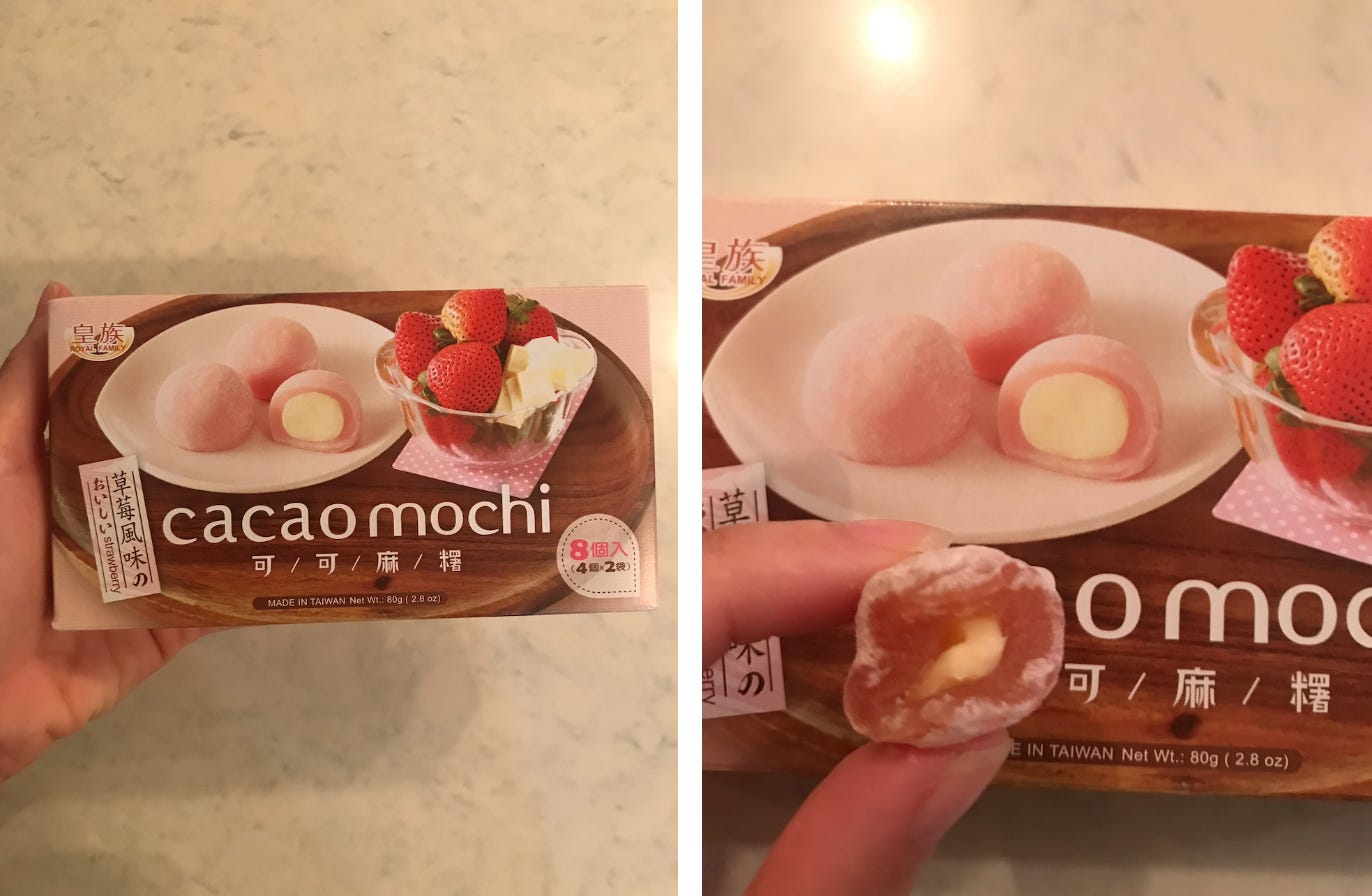How to boycott the produce section
On weekend markets as a supermarket alternative, the country's most glamorous spud and a squishy snack that's been photoshopped beyond recognition.
Nau mai, haere mai. Welcome to The Boil Up, The Spinoff’s weekly food newsletter produced in partnership with Boring Oat Milk. Written by me, Charlotte Muru-Lanning. It’s lovely to have you here!
I’ve recently done something kind of traitorous. After years of loyalty to West Auckland’s Avondale Market, I’ve switched to South Auckland’s Ōtara Market. My heart will forever have equal space for both morning markets, each delightful in its own distinct way, but the switch was sparked mostly by a yearning for change, the fact that Ōtara Market is slightly smaller and, probably most importantly, there’s a Māori-helmed stall with the best mussel fritters in town – a superlative start to your Saturday morning. (You could technically go to both markets as they’re on different days, but I think that’s excessive – even for the market obsessed like myself.)
I talk about markets so often because they’re the centre of my kai universe. I promise that I do actually eat out on occasion, but the rituals of buying fresh fruit and vegetables at the markets, taking them home, washing them, planning what to make with them and then the best part, eating it all throughout the week makes up such a huge portion of my daily relationship with kai that it would be weird if I didn’t talk about it in this newsletter every now and then. And as I’ve probably said previously, in an era where food inflation and the supermarket duopoly plague our experiences of kai, markets are a balm.
Take for example my haul from last weekend, of jubilantly frilled kale; a heap of button mushrooms, potatoes and kūmara (still expensive, but not shockingly so); a cauliflower globe, the burliest whole celery I’ve ever seen; fat baby bok choy; a requisite bunch of flat leaf parsley; and posies of radishes and carrots still traced with the dirt that they were plucked from: $26.50. All with a complimentary side of hustle and bustle, megaphone sermons, ever-changing music, crisp air, bartering and conversation.
The same kai added to my online cart on Countdown’s website: $50.98. Almost double the price of the market and minus any of the weekend morning theatre and fizz. And flat leaf parsley wasn’t even in stock the day I checked.
Granted, weekend markets are, for myriad reasons, not for everyone. As noisy, often cramped spaces, the market can be inaccessible for people with disabilities and in many cases, their locations are prohibitive if you don’t have access to a car. A market no doubt requires more time than a trip to the supermarket, and unless you have evolved into some kind of creature who can survive on fresh fruit and veg alone, probably still means you’ll have to visit one for all the other things you need to survive.
Because the food available at markets tends toward the seasonal, you might not find the out-of-season produce we’re so used to in the supermarket – so you need to be slightly more thoughtful. This only gets easier the more you go, as you get used to the ebbs and flows of availability and where your favourite stalls are.
But more than just a place for a bargain, markets are an activity; a weekly event of which no two are the same. On a recent visit to the Ōtara market I spotted an uncle with three fresh frangipani tied to a lanyard with satin ribbon. The weekend before that, a woman walked past me beaming the widest smile you can imagine – and of course she was, she was pushing a pram with a pooch inside. Last weekend I eavesdropped on a (from what I could tell) constructive conversation about co-governance between stall holders. It’s all happening at the markets.
Still, despite buying produce from the market, I’m not entirely free from the grips of supermarket culture. In fact, sadly, not at all. That is to say, I still get to experience that sense of bafflement at the checkout when you silently blink back and forth between your five essential items and the extravagant price just rung up on the till.
But I like to think of my purchases at the market as a kind of one-woman strike against those discombobulating supermarket prices – even if it is limited to my fridge crisper drawer – in the vein of consumer boycotts against rising prices and shrinking products. Just as currently, Italian consumer rights groups are calling for a 15-day “pasta strike” to protest prices for the staple product that have risen at double their rate of inflation, this is my own quiet protest that says, “no, I won’t be paying $4.75 for your wilting bunch of curly parsley, nor will I be splashing out $7 (described as a “great price”) for a 400g bag of sterile-looking mushrooms thank you”.
As winter takes hold, there's not much better for taking the edge off an icy evening (or morning, for that matter) than a warm and steaming slice of something sweet. Created with stonefruit in mind – but just as good with apples, pears or whatever's in season and on special – Carter Were's oat milk upside down cake is the perfect balm for your mid-year chills. Get the recipe here.
Weekly bites
National Party leader Christopher Luxon has announced a plan to end an effective ban on gene editing (GE) and genetic modification (GM) if the party wins this year’s election. The leader told TVNZ’s Q+A that he would overhaul the country's strict laws governing biotechnology, which have been in place since 2003, and introduce a new regulator for GM and GE. While applications of GM and GE include medicine, research and industry – probably one of the most controversial is within food production by way of modified livestock or crops. Tensions around whether we should allow genetic engineering in Aotearoa have been raging for almost as long as the technology has been around – since the 1970s. At the turn of the 21st century, public opinion was firmly anti-GMO, which led to protests, including a famous hīkoi. The Productivity Commission recommended in its 2021 report that New Zealand’s strict laws regulating genetic engineering be reviewed. However, Māori have raised concerns about the implications of GE and GM when it comes to potential for monocultures, Māori IP theft and complexities around tikanga, along with a lack of engagement with Māori in relation to Luxon’s proposed changes.
A couple who found that their bottomless brunch was not-quite-so-bottomless have successfully sued the restaurant in the Disputes Tribunal, reports NZ Herald. The pair paid the set price of $65 each but were told after their first round of food that if they wanted more to eat they’d have to pay extra as the “bottomless” was limited to drinks only. Despite the couple hoping for a hearty $2,000 compensation for the “misleading” terms and conditions, the tribunal, which released its decision last week, awarded them each $25, saying that the restaurant breached Fair Trading Act by not displaying the terms of the brunch more clearly.
Since opening in 2016, Auckland degustation restaurant Pasture has been the focus of both praise and criticism. But late last month, the doors to Pasture and its two sibling eateries quietly closed. I took a look at the confusion the sudden closure caused customers who had bookings cancelled – one of whom had paid a $1,755 deposit – and why, despite the restaurant being closed, reservations that required deposits upward of $75 per person remained open online (since the article was published, bookings have been closed). The owner has since made an announcement on Pasture’s Instagram about the closure, saying, “[w]e will continue, as we have, to refund deposits in an ongoing basis, for all existing reservations.”
I did want to flag a very important update to the article that was made as soon as we were made aware. Despite stating in the article published on Saturday that they were yet to receive an update from the restaurant about their deposit refund, our source had in fact missed an email from Pasture that landed on Thursday evening, and has since received their refund. It is regrettable that this particular detail was published, but the reality of reporting on evolving situations. We’ll be keeping an eye on future developments in the space.
“Try me, ‘cos I’m gorgeous,” purrs the anthropomorphised “potato lady” who adorns the hot pink Pyper’s Desirèe potato bags. On The Spinoff, Tara Ward writes on her affection for New Zealand’s most glamorous spud. Where does this long-lashed starchy enchantress come from? How old is she? How does she keep her lashes so long? And where is she heading with those slinky black opera gloves? She’s a mystery girl. Always an enigma, and an icon for ever.
Also on The Spinoff, which has had so much brilliant food content this week I can barely fit it in this newsletter: Shanti Mathias writes about New Zealand’s lacklustre mango options and Alex Casey dives into the online fandom behind the Christchurch New World that’s simultaneously the crème de la crème of the country’s supermarkets and one of the priciest.
The support of our members ensures we can continue to employ and commission diverse voices covering stories from a range of perspectives and make them freely available to all. From Spinoff stalwarts Toby Manhire and Alex Casey to emerging talents like Charlotte Muru-Lanning and Shanti Mathias, our journalists and contributors do valuable work that is only possible with the support of readers like you. If you can, support the team and donate today.
Snack of the week
Taiwan dessert cacao mochi strawberry, $2.99 from Jadan supermarket: They’re a far cry from the plumply opaque mounds brimming with white chocolate filling promised on the front of their box. Instead, when I cracked open this packet of strawberry-flavoured mochi, a rather deflated and ominously coloured specimen revealed itself. When bitten into, the filling, not plush as I’d envisioned, was more a whisper of chocolate, and a far cry from the clearly heavily-photoshopped ideal of itself presented on the packaging. There was still some likeness though: the mochi were moulded into little spherical mounds and I suppose they were still technically pink, even if not in the expected cherry-blossom-esque tone. On texture, arguably the most important aspect in the case of mochi, they lacked a heavy chew but the sticky jelly-like bounce remained a joy to eat. Still, I couldn’t help mourn the absence of a firmer white chocolate centre that I’d anticipated would provide contrast. For the most part a perfectly yum snack, if not a little disappointing. This would have been perfectly delicious if my expectations weren’t so vastly removed from the reality of these little mochi. Proof I suppose that even mochi can fall victim to the cult of photoshopped beauty standards. 6/10
Talk next week!
Hei kōnā mai, Charlotte



















In Australia, they now do the "ugly" vegetables section that's sold for slightly lower
I think of my weekly market visit as a one woman stand against the supermarket as well! Such a good part of the week.